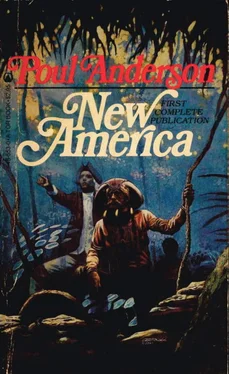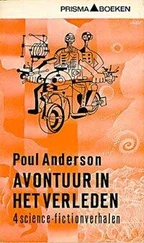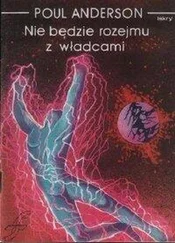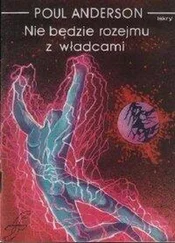Doppler effect, perhaps more widely familiar, is the shift in observed wavelength from an emitting object, when the observer’s velocity changes. If we move away from a star, we see its light reddened; if we move toward a star, we see its light turned more blue. Again, these changes become extremely marked as we approach c.
Eventually our relativistic astronaut sees most of the stars gathered in a ring ahead of him, though a few sparsely strewn individuals remain visible elsewhere. The ring itself, which Frederik Pohl has dubbed the “starbow,” centers on a circle which is mainly dark, because nearly all light from there has been blue-shifted out of the frequencies we can see. The leading or inner edge of the ring is bluish white, its trailing or outer edge reddish; in between is a gradation of colors, akin to what we normally observe. Fred Hollander, a chemist at Brookhaven National Laboratories, has calculated the starbow’s exact appearance for different v. It gets narrower and moves farther forward, the bull’s eye dead ahead gets smaller and blacker, the faster we go—until, for instance, at 0.9999c we perceive a starbow about ten degrees of arc in width, centered on a totally black circle of about the same diameter, and little or nothing shows anywhere else in the sky.
At that speed, 0.9999c, we’d cross 100 light-years in 20 months of our personal lifetimes. So it’s worth trying for; but we’ll have to figure out some means of knowing where we are! Though difficult, the problem does not look unsolvable in principle.
It may become so beyond a certain velocity. If we travel under acceleration the whole way, speeding up continuously to the half-way point, thereafter braking at the same rate until we reach our goal: then over considerable distances we get truly staggering relativity factors. The longer a voyage, the less difference it makes to us precisely how long it is.
Thus, Dr. Sagan points out that explorers faring in this wise at one gravity will reach the nearer stars within a few years, Earth time, and slightly less, crew time. But they will cross the approximately 650 light-years to Deneb in 12 or 13 years of their own lifespans; the 30,000 light-years to the center of our galaxy in 21 ship years; the two million light-years to the Andromeda galaxy in 29 ship years; or the 10 million light-years to the Virgo cluster of galaxies in 31 ship years. If they can stand higher accelerations, or have some way to counteract the drag on their bodies, they can cross these gulfs in less of their own time; the mathematical formula governing this is in the appendix.
But will the starbow become too thin and dim for navigation? Or will they encounter some other practical limit? For instance, when matter is accelerated, it radiates energy in the form of gravity waves. The larger the mass, the stronger this radiation; and of course the mass of our spaceship will be increasing by leaps and bounds and pole-vaults. Eventually it may reach a condition where it is radiating away as much energy as it can take in, and thus be unable to go any faster.
However, the real practical limit is likelier to arise from the fact that we have enough stars near home to keep us interested for millennia to come. Colonies planted on worlds around some of these can, in due course, serve as nuclei for human expansion ever further into the universe.
Because many atoms swept through its force-fields are bound to give off light, a ramjet under weigh must be an awesome spectacle. At a safe distance, probably the hull where the crew lives is too small for the naked eye. Instead, against the constellations one sees a translucent shell of multicolored glow, broad in front, tapering aft to a fiery point where the nuclear reaction is going on. (Since this must be contained by force-fields anyway, there is no obvious reason for the fusion chamber to be a metal room.) Thence the exhaust streams backward, at first invisible or nearly so, where its particles are closely controlled, but becoming brilliant further off as they begin to collide, until finally a nebula-like chaos fades away into the spatial night.
It’s not only premature, it’s pointless to worry about limitations. Conventional physics appears to tell us that, although nature has placed an eternal bound on the speed of our traveling, the stars can still be ours… if we really want them.
Yet we would like to reach them more swiftly, with less effort. Have we any realistic chance whatsoever of finding a way around the light-velocity barrier?
Until quite recently, every sensible physicist would have replied with a resounding “No.” Most continue to do so. They point to a vast mass of experimental data; for instance, if subatomic particles did not precisely obey Einsteinian laws, our big accelerators wouldn’t work. The conservatives ask where there is the slightest empirical evidence for phenomena which don’t fit into the basic scheme of relativity! And they maintain that, if ever we did send anything faster than light, it would violate causality.
I don’t buy that last argument, myself. It seems to me that, mathematically and logically, it presupposes part of what it sets out to prove. But this gets a bit too technical for the present essay, especially since many highly intelligent persons disagree with me. Those whom I mentioned are not conservatives in the sense of having stick-in-the-mud minds. They are among the very people whose genius and imagination make science the supremely exciting, creative endeavor which it is these days.
Nevertheless we do have a minority of equally qualified pioneers who have lately been advancing new suggestions.
I suppose the best known idea comes from Gerald Feinberg, professor of physics at Columbia University. He has noted that the Einsteinian equations do not actually forbid material particles which move faster than light—if these have a mass that can be described by an imaginary number (that is, an ordinary number multiplied by the square root of minus one. Imaginary quantities are common, e.g., in the theory of electromagnet-ism). Such “tachyons,” as he calls them, would travel faster and faster the less energy they have; it would take infinite energy to slow them down to c, which is thus a barrier for them too.
Will it forever separate us, who are composed of “tardyons,” from the tachyon part of the cosmos? Perhaps—but not totally. It is meaningless to speak of anything which we cannot, in principle, detect if it exists. If tachyons do, there must be some way by which we can find experimental evidence for them, no matter how indirect. This implies some kind of interaction (via photons?) with tardyons. But interaction, in turn, implies a possibility of modulation. That is, if they can affect us, we can affect them.
And… in principle, if you can modulate, you can do anything. Maybe it won’t ever be feasible to use tachyons to beam a man across space; but might we, for instance, use them to communicate faster than light?
Needless to say, first we have to catch them, i.e. show that they exist. This has not yet been done, and maybe it never can be done because in fact there aren’t any. Still, one dares hope. A very few suggestive data are beginning to come out of certain laboratories—
Besides, we have other places to look. Hyper-space turns out to be more than a hoary science fiction catchphrase. Geometrodynamics now allows a transit from point to point, without crossing the space between, via a warp going “outside” that space—often called a wormhole. Most worm-holes are exceedingly small, of subatomic dimensions; and a trip through one is no faster than a trip through normal space. Nevertheless, the idea opens up a whole new field of research, which may yield startling discoveries.
Black holes have been much in the news, and in science fiction, these past several years. They are masses so dense, with gravity fields so strong, that light itself cannot escape. Theory has predicted for more than 40 years that all stars above a particular size must eventually collapse into the black hole state. Today astronomers think they have located some, as in Cygnus X-l. And we see hypotheses about black holes of less than stellar mass, which we might be able to find floating in space and utilize.
Читать дальше











